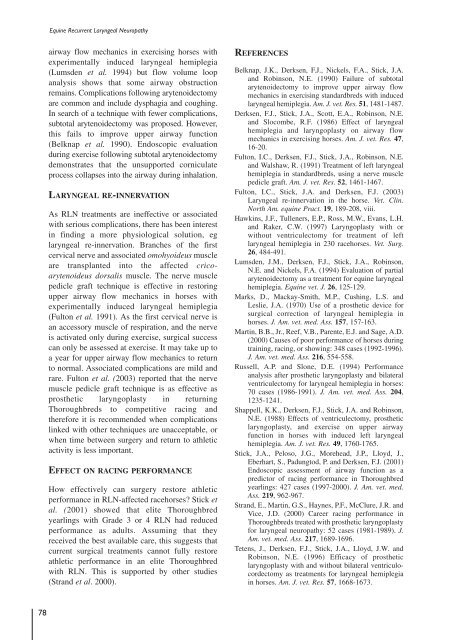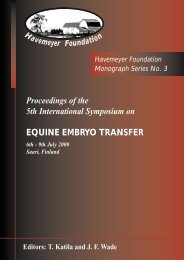Proceedings of a Workshop on - The Havemeyer Foundation
Proceedings of a Workshop on - The Havemeyer Foundation
Proceedings of a Workshop on - The Havemeyer Foundation
You also want an ePaper? Increase the reach of your titles
YUMPU automatically turns print PDFs into web optimized ePapers that Google loves.
Equine Recurrent Laryngeal Neuropathy<br />
airway flow mechanics in exercising horses with<br />
experimentally induced laryngeal hemiplegia<br />
(Lumsden et al. 1994) but flow volume loop<br />
analysis shows that some airway obstructi<strong>on</strong><br />
remains. Complicati<strong>on</strong>s following arytenoidectomy<br />
are comm<strong>on</strong> and include dysphagia and coughing.<br />
In search <str<strong>on</strong>g>of</str<strong>on</strong>g> a technique with fewer complicati<strong>on</strong>s,<br />
subtotal arytenoidectomy was proposed. However,<br />
this fails to improve upper airway functi<strong>on</strong><br />
(Belknap et al. 1990). Endoscopic evaluati<strong>on</strong><br />
during exercise following subtotal arytenoidectomy<br />
dem<strong>on</strong>strates that the unsupported corniculate<br />
process collapses into the airway during inhalati<strong>on</strong>.<br />
LARYNGEAL RE-INNERVATION<br />
As RLN treatments are ineffective or associated<br />
with serious complicati<strong>on</strong>s, there has been interest<br />
in finding a more physiological soluti<strong>on</strong>, eg<br />
laryngeal re-innervati<strong>on</strong>. Branches <str<strong>on</strong>g>of</str<strong>on</strong>g> the first<br />
cervical nerve and associated omohyoideus muscle<br />
are transplanted into the affected cricoarytenoideus<br />
dorsalis muscle. <strong>The</strong> nerve muscle<br />
pedicle graft technique is effective in restoring<br />
upper airway flow mechanics in horses with<br />
experimentally induced laryngeal hemiplegia<br />
(Fult<strong>on</strong> et al. 1991). As the first cervical nerve is<br />
an accessory muscle <str<strong>on</strong>g>of</str<strong>on</strong>g> respirati<strong>on</strong>, and the nerve<br />
is activated <strong>on</strong>ly during exercise, surgical success<br />
can <strong>on</strong>ly be assessed at exercise. It may take up to<br />
a year for upper airway flow mechanics to return<br />
to normal. Associated complicati<strong>on</strong>s are mild and<br />
rare. Fult<strong>on</strong> et al. (2003) reported that the nerve<br />
muscle pedicle graft technique is as effective as<br />
prosthetic laryngoplasty in returning<br />
Thoroughbreds to competitive racing and<br />
therefore it is recommended when complicati<strong>on</strong>s<br />
linked with other techniques are unacceptable, or<br />
when time between surgery and return to athletic<br />
activity is less important.<br />
EFFECT ON RACING PERFORMANCE<br />
How effectively can surgery restore athletic<br />
performance in RLN-affected racehorses? Stick et<br />
al. (2001) showed that elite Thoroughbred<br />
yearlings with Grade 3 or 4 RLN had reduced<br />
performance as adults. Assuming that they<br />
received the best available care, this suggests that<br />
current surgical treatments cannot fully restore<br />
athletic performance in an elite Thoroughbred<br />
with RLN. This is supported by other studies<br />
(Strand et al. 2000).<br />
REFERENCES<br />
Belknap, J.K., Derksen, F.J., Nickels, F.A., Stick, J.A.<br />
and Robins<strong>on</strong>, N.E. (1990) Failure <str<strong>on</strong>g>of</str<strong>on</strong>g> subtotal<br />
arytenoidectomy to improve upper airway flow<br />
mechanics in exercising standardbreds with induced<br />
laryngeal hemiplegia. Am. J. vet. Res. 51, 1481-1487.<br />
Derksen, F.J., Stick, J.A., Scott, E.A., Robins<strong>on</strong>, N.E.<br />
and Slocombe, R.F. (1986) Effect <str<strong>on</strong>g>of</str<strong>on</strong>g> laryngeal<br />
hemiplegia and laryngoplasty <strong>on</strong> airway flow<br />
mechanics in exercising horses. Am. J. vet. Res. 47,<br />
16-20.<br />
Fult<strong>on</strong>, I.C., Derksen, F.J., Stick, J.A., Robins<strong>on</strong>, N.E.<br />
and Walshaw, R. (1991) Treatment <str<strong>on</strong>g>of</str<strong>on</strong>g> left laryngeal<br />
hemiplegia in standardbreds, using a nerve muscle<br />
pedicle graft. Am. J. vet. Res. 52, 1461-1467.<br />
Fult<strong>on</strong>, I.C., Stick, J.A. and Derksen, F.J. (2003)<br />
Laryngeal re-innervati<strong>on</strong> in the horse. Vet. Clin.<br />
North Am. equine Pract. 19, 189-208, viii.<br />
Hawkins, J.F., Tulleners, E.P., Ross, M.W., Evans, L.H.<br />
and Raker, C.W. (1997) Laryngoplasty with or<br />
without ventriculectomy for treatment <str<strong>on</strong>g>of</str<strong>on</strong>g> left<br />
laryngeal hemiplegia in 230 racehorses. Vet. Surg.<br />
26, 484-491.<br />
Lumsden, J.M., Derksen, F.J., Stick, J.A., Robins<strong>on</strong>,<br />
N.E. and Nickels, F.A. (1994) Evaluati<strong>on</strong> <str<strong>on</strong>g>of</str<strong>on</strong>g> partial<br />
arytenoidectomy as a treatment for equine laryngeal<br />
hemiplegia. Equine vet. J. 26, 125-129.<br />
Marks, D., Mackay-Smith, M.P., Cushing, L.S. and<br />
Leslie, J.A. (1970) Use <str<strong>on</strong>g>of</str<strong>on</strong>g> a prosthetic device for<br />
surgical correcti<strong>on</strong> <str<strong>on</strong>g>of</str<strong>on</strong>g> laryngeal hemiplegia in<br />
horses. J. Am. vet. med. Ass. 157, 157-163.<br />
Martin, B.B., Jr., Reef, V.B., Parente, E.J. and Sage, A.D.<br />
(2000) Causes <str<strong>on</strong>g>of</str<strong>on</strong>g> poor performance <str<strong>on</strong>g>of</str<strong>on</strong>g> horses during<br />
training, racing, or showing: 348 cases (1992-1996).<br />
J. Am. vet. med. Ass. 216, 554-558.<br />
Russell, A.P. and Sl<strong>on</strong>e, D.E. (1994) Performance<br />
analysis after prosthetic laryngoplasty and bilateral<br />
ventriculectomy for laryngeal hemiplegia in horses:<br />
70 cases (1986-1991). J. Am. vet. med. Ass. 204,<br />
1235-1241.<br />
Shappell, K.K., Derksen, F.J., Stick, J.A. and Robins<strong>on</strong>,<br />
N.E. (1988) Effects <str<strong>on</strong>g>of</str<strong>on</strong>g> ventriculectomy, prosthetic<br />
laryngoplasty, and exercise <strong>on</strong> upper airway<br />
functi<strong>on</strong> in horses with induced left laryngeal<br />
hemiplegia. Am. J. vet. Res. 49, 1760-1765.<br />
Stick, J.A., Peloso, J.G., Morehead, J.P., Lloyd, J.,<br />
Eberhart, S., Padungtod, P. and Derksen, F.J. (2001)<br />
Endoscopic assessment <str<strong>on</strong>g>of</str<strong>on</strong>g> airway functi<strong>on</strong> as a<br />
predictor <str<strong>on</strong>g>of</str<strong>on</strong>g> racing performance in Thoroughbred<br />
yearlings: 427 cases (1997-2000). J. Am. vet. med.<br />
Ass. 219, 962-967.<br />
Strand, E., Martin, G.S., Haynes, P.F., McClure, J.R. and<br />
Vice, J.D. (2000) Career racing performance in<br />
Thoroughbreds treated with prosthetic laryngoplasty<br />
for laryngeal neuropathy: 52 cases (1981-1989). J.<br />
Am. vet. med. Ass. 217, 1689-1696.<br />
Tetens, J., Derksen, F.J., Stick, J.A., Lloyd, J.W. and<br />
Robins<strong>on</strong>, N.E. (1996) Efficacy <str<strong>on</strong>g>of</str<strong>on</strong>g> prosthetic<br />
laryngoplasty with and without bilateral ventriculocordectomy<br />
as treatments for laryngeal hemiplegia<br />
in horses. Am. J. vet. Res. 57, 1668-1673.<br />
78








